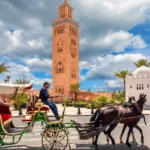Nestled at the foot of the Atlas Mountains, Marrakech, often referred to as “The Red City,” stands as a beacon of Morocco’s rich history and vibrant culture. Known for its reddish hues, bustling souks, and captivating architecture, Marrakech has become one of the most sought-after travel destinations in the world. Whether you’re an avid traveler, a history buff, or someone in search of adventure, Marrakech offers a unique experience that leaves a lasting impression.
A Glimpse Into the History of Marrakech
Founded in 1070 by the Almoravid dynasty, Marrakech quickly became a cultural and religious hub. The city earned its nickname, “The Red City,” from the reddish sandstone used to construct its buildings and the towering walls that surround it. Over the centuries, Marrakech evolved into a melting pot of Berber, Arab, and Andalusian influences, shaping its distinct character and charm.The city also served as a key trading hub, connecting Africa, Europe, and the Middle East. This legacy remains visible in the vibrant markets and cosmopolitan atmosphere that define the city today.Exploring the Medina: A UNESCO World Heritage Site
The heartbeat of Marrakech is its medina, a maze-like old city filled with narrow alleys, bustling souks, and historic landmarks. Listed as a UNESCO World Heritage Site, the medina is a sensory overload that captivates visitors with its sights, sounds, and scents.- Jemaa el-Fna Square: The iconic square is a dynamic space where storytellers, snake charmers, and food vendors gather to create an electrifying ambiance. By night, the square transforms into a vibrant food market offering Moroccan delicacies like tagines, couscous, and fresh orange juice.
- Koutoubia Mosque: As the tallest structure in Marrakech, the Koutoubia Mosque is a stunning example of Almohad architecture. While non-Muslims are not permitted inside, its majestic exterior and gardens are a must-see.
- Ben Youssef Madrasa: This 14th-century Islamic school is a masterpiece of Moroccan architecture, adorned with intricate mosaics, cedar wood carvings, and zellij tiles.
The Colors and Charms of Marrakech’s Souks
The souks of Marrakech are a shopper’s paradise. Here, you can find an array of handmade goods, from traditional Berber rugs and leather goods to spices and jewelry. Key tips for navigating the souks include bargaining with vendors, staying aware of your surroundings, and being open to discovering hidden treasures.Palaces and Gardens: Tranquil Escapes
Amid the city’s bustling energy, Marrakech offers serene retreats in the form of its palaces and gardens.- Bahia Palace: A stunning 19th-century palace showcasing intricate stucco work, colorful tiles, and lush courtyards.
- Majorelle Garden: Designed by French painter Jacques Majorelle and later restored by Yves Saint Laurent, this garden is a lush oasis of exotic plants, cobalt-blue buildings, and peaceful walkways.
- Menara Gardens: Located near the Atlas Mountains, these gardens are perfect for a tranquil escape and offer spectacular photo opportunities.
Experiencing Moroccan Cuisine
Marrakech is a culinary delight that blends flavors, spices, and traditions. From the fragrant tagines and savory pastillas to sweet treats like chebakia and maamoul, the city’s cuisine is as diverse as its culture. Don’t miss dining in a traditional riad, where meals are served in beautifully decorated courtyards.Marrakech Beyond the City Walls
For those seeking adventure, Marrakech is the gateway to incredible day trips and excursions.- Atlas Mountains: A haven for hikers and nature lovers, these mountains offer breathtaking views and insights into Berber culture.
- Agafay Desert: Just a short drive from Marrakech, the Agafay Desert provides an excellent opportunity for camel rides and luxury camping under the stars.
- Essaouira: This coastal city, with its windswept beaches and historic medina, is perfect for a day trip.
Practical Tips for Visiting Marrakech
- Best Time to Visit: The ideal times are spring (March to May) and autumn (September to November), when temperatures are moderate.
- Local Customs: Respect Moroccan traditions, especially when visiting religious sites. Dress modestly and learn a few Arabic or French phrases to connect with locals.
- Getting Around: While the medina is best explored on foot, you can use taxis or calèches (horse-drawn carriages) to explore the rest of the city.




